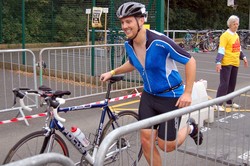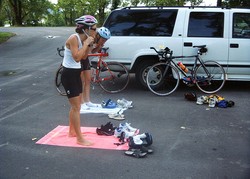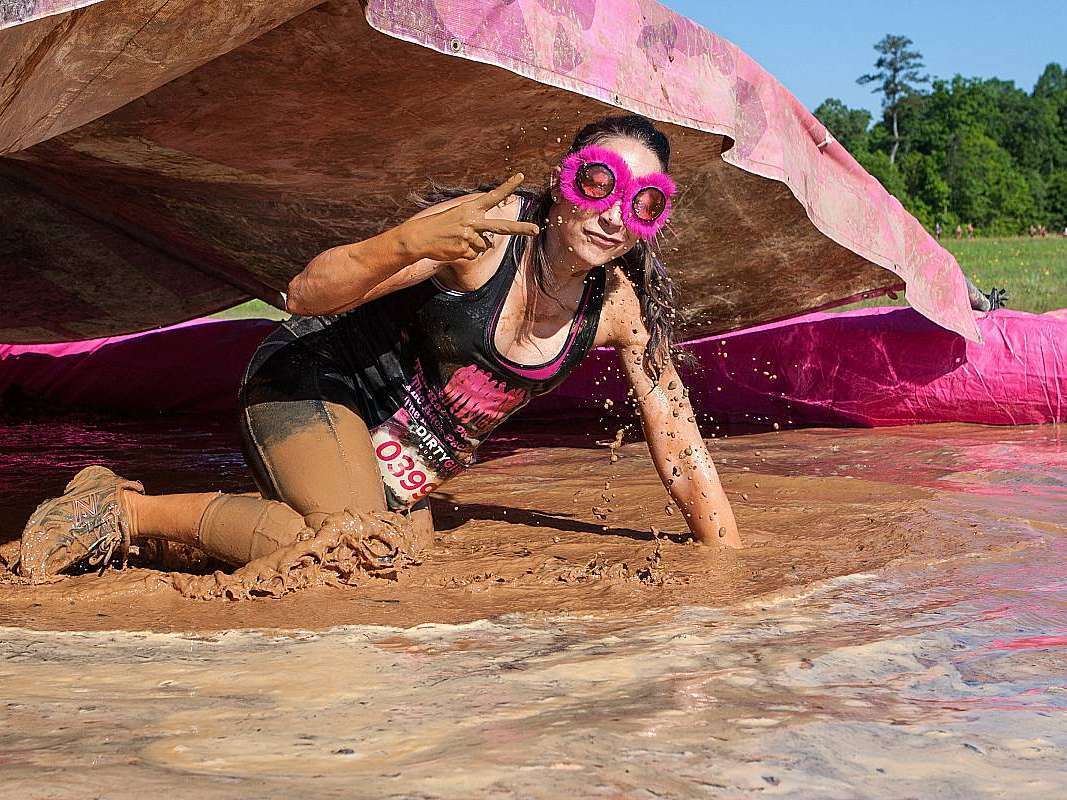 You spend countless miles and hours in the water, on the bike, and pounding the pavement running, training for a triathlon.
You spend countless miles and hours in the water, on the bike, and pounding the pavement running, training for a triathlon.
Sometimes it’s just a matter of minutes or seconds between one competitor who places in their division, and another competitor who doesn’t. So why squander away time with bad transitions?
It would presumably take hundreds of training hours to lop 2 minutes off your swim time, and yet 1 hour of transition practice would likely take 2 minutes off your transition time.
Each triathlon has 2 transitions:
(T1) a swim-to-bike transition
Newbie triathletes often think of these transitions as a place to rest, regroup, celebrate the completion of one leg of the race, and prepare for the next.
Transition areas can also have a lot of distractions that entice a triathlete to waste precious time. Chatty volunteers, food and drink, and the general chaos of athletes going in all directions can cause you to lose focus. Leave your celebration and chit chat for the end of the race; transitions are about successfully transitioning yourself into the next leg of the triathlon as quickly as possible.
Tips For Faster Triathlon Transitions
#1 Use a gear bag.
You need some sort of gym bag or backpack that can carry and transport all of your transition area gear.
You don’t want your tri stuff strewn all over your car or separated in 3 different bags; that’s how goggles, sports gels, and bike shades mysteriously vanish. Pack all your stuff in 1 bag. It’s easier to tote and unpack 1 bag in your transition area.
You can purchase a transition-specific triathlon bag, or use a more general sports bag. There are lots of options in a wide range of prices. Whatever works for you; use one.
#2 Do a trial run.
On race day, arrive with plenty of time to survey the transition area before the race, and to set up your transition space.
I suggest you practice your run-ups and exits so you know exactly where to go. Be sure you can find your bike and know your path in and out of the transition area.
Lay out all your transition gear, and do a trial run (even if it’s just in your mind) to be sure everything you need is where you need it and ready to go.
#3 Reduce the number of transition tasks.
In the T1 transition, the only thing that you must do before leaving the transition area according to USAT rules is put on your helmet.
Some triathletes leave their shoes attached to the bike pedals, and they slide into them while riding. Set your bike up in the transition area with your shoes attached to the pedals; rubber bands looped between the heels and frame will hold them horizontal.
Once on your bike, pedal with your feet on top of your shoes. When you are cruising at speed, coast and slip your feet into your shoes. Keep your eyes ahead on the road, not down on your feet.
On the return, slip your feet out of your shoes before you reach T2. You’ll want to practice this skill first on an indoor trainer before doing it in road training or in a triathlon event.
Cycling sunglasses can be looped over the handlebars and put on while riding, along with cycling gloves. Food and drink are already attached to the bike so you can fuel on the road, as opposed to taking the time to do so in the transition area.
In the T2 transition, the main thing is to change your shoes. Your race number, fuel belt, hat, and sunglasses can be put on while you run; don’t take time to do it in the triathlon area.
Some triathletes run (and bike) without socks to save time. Frankly, changing articles of clothing such as socks are the most time-consuming aspects of transitions.
Experiment and see what tasks you are capable of doing while biking and running; don’t do something you have not practiced or feel comfortable with.
#4 Practice transitions.
-
Running with your bike
-
Getting into your cycling shoes attached to your bike
-
Putting on your race belt or fuel belt while you run
…These are just some of the skills you will want to practice.
In addition, establish a T1 and T2 sequence that you plan to follow every time.
Happy transitioning!




